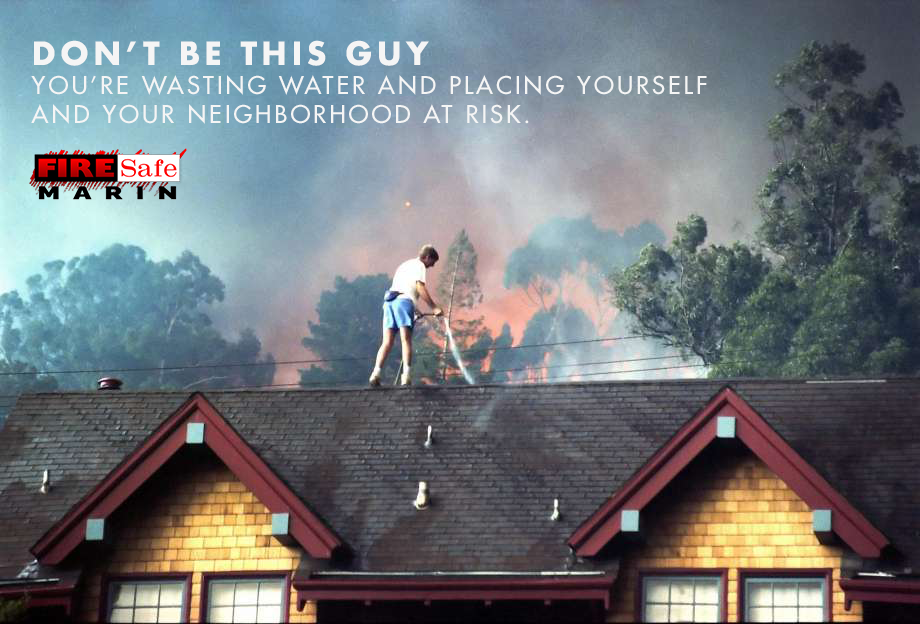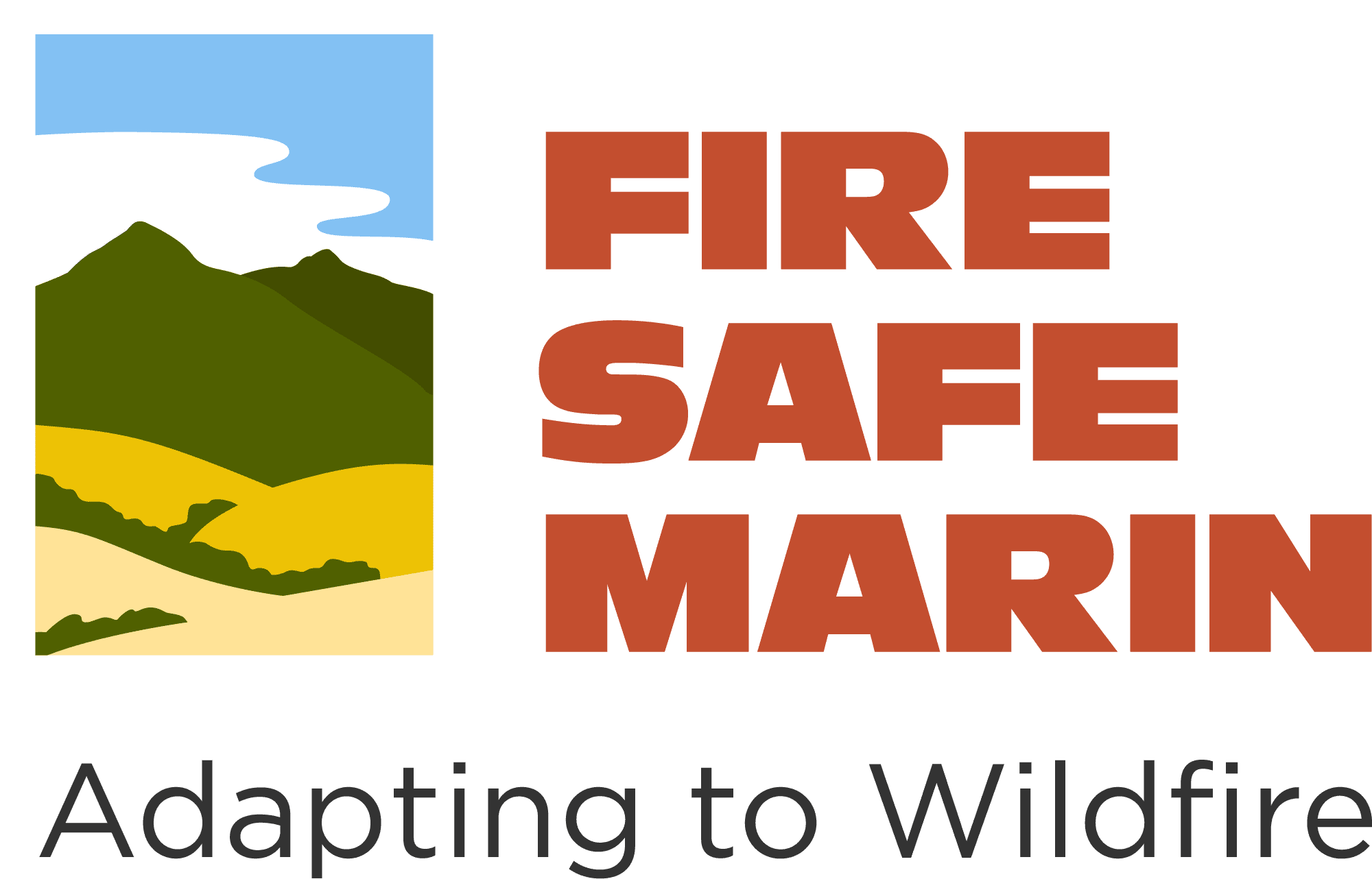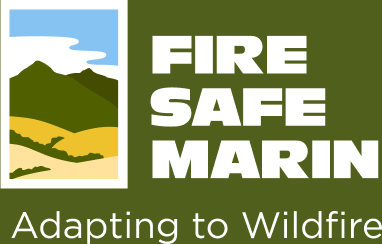
At Fire Safe Marin, we are very happy to see many Marin neighborhoods becoming engaged about wildfire safety. During a recent online discussion, one clever neighbor suggested installing “rain-bird” type sprinklers on a roof as a way to prevent embers from igniting a home. Discussions and suggestions to improve fire safety among neighbors are extremely valuable, and will benefit us all in the long-run. That said, this particular suggestion (turning on rain-bird sprinklers when a wildfire is burning nearby) is not advised, for a number of reasons.
First, the concept of sprinklers on the roof is not new. This has been attempted thousands of times during wildfires, with very limited success. In your community particularly, there are potential drawbacks that lead Fire Safe Marin and local fire agencies to strongly discourage the practice.
- Wide-scale activation of sprinklers and garden hoses can dramatically reduce water pressure in the entire community. Firefighters apply water judiciously, where it actually makes a difference, and will need all available water and water pressure.
- If the fire is close enough to make turning-on a manually operated sprinkler system a viable option, you should ave already evacuated. In-turn, turning on the water in advance can potentially drain local water supply tanks and reduces water pressure available for firefighting (see above). Fire is dynamic and difficult to predict – in most situations, you will not have enough information to know when the fire might reach your house.
- Climbing your roof when a fire approaches is dangerous. If you fall or are are injured, firefighters will need to rescue you instead of fighting the fire.
- If you have a fire resistant roof, and keep it (and rain gutters) clean at all times during fire season as you are REQUIRED to do, sprinklers will not make a difference for your house!
- Local fire agencies agree that the only time a sprinkler system on the roof MAY be advisable is if you have a combustible wood roof. Fire Safe Marin recommends that you replace any wood-shake roof with a fire-sesistant “Type A” roof assembly, but until that happens, your house is the rare case a sprinkler might be helpful. Contact your local Fire Marshal for advice.
- Likewise, don’t climb up on your roof with a garden hose. You’ve seen it on the news – Californians dutifully stand on their roof with a garden hose and watch the firefighters work nearby. This is dangerous (you should have already evacuated, and your shorts and tennies won’t protect you if the fire reaches you), not to mention completely ineffective.
As your neighborhood becomes more active in wildfire prevention, you’ll likely find many products and engineering ideas that will be sold to you under the guise of reducing your risk. Some may be effective, many are not. Products like “fireproof” paint, heat activated shutters, automatic (exterior) sprinkler systems, foam and gel coatings, even whole house fire retardant blankets are all available, and many are a waste of money. Contact your local Fire Department or Fire Safe Marin before purchasing anything intended to “fireproof” your home (this does not apply to the WUI building products required by Chapter 7A of the Building Code).
There are three strategies that are PROVEN to protect your home from wildfires:
- Defensible Space: It’s required by law and extremely effective at reducing your home’s exposure to radiant heat and protecting from embers. A clean roof is part of maintaining Defensible Space, same as maintaining and removing combustible vegetation for 100′ (or to your property line).
- Hardening Your Home: steps taken in advance to “harden” your home against wildfire include maintaining a fire resistant “Class A” roof (required for all new construction and remodels); covering ALL vents with 1/8″ or smaller wire mesh; caulking all openings and cracks in siding, eaves, rafters, etc; removing combustibles above and below decks; sealing doors and windows with weather stripping to keep out embers; updating windows to multi-paned tempered glass; and many more online at www.firesafemarin.org/
hardening-your-home - Community Scale Vegetation Management: this requires working together as a community, cooperating with neighbors, and altering your mindset to understand that we need to maintain local forest and vegetation communities in a healthy state. This can only happen when everyone works together – it’s everyone’s responsibility.
As a parting reminder, here’s a look at the beautiful Sperry Chalet in Glacier National Park earlier this summer. The historic 1913 Chalet had an extensive sprinkler system on it’s roof when a wildfire approached last month:


Here’s a look at Sperry Chalet August 31, and again, today:


Important things to note:
- Firefighters had two days to prepare the building. They wrapped windows in fire resistant blankets and turned on sprinklers when the fire approached.
- The fire did not start on the roof.
- A single ember found its way in through a gap in between the (stone!) siding and the roof.
- The vegetation around the structure never burned. The ember came from hundreds of yards away.
- Read more here…







